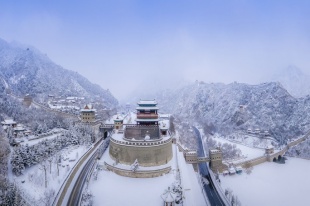Juyong Pass


The Juyong Pass, also known as the Juyongguan Great Wall, is located near the Badaling Great Wall in the southern section of Changping District, Beijing. This section is one of the most recently restored parts of the historic Great Wall of China, traversing one of its several narrow passes. The Juyong Pass is situated in the middle of a gully approximately 20 kilometers long. To the north of Juyongguan lies the important city of Zhangjiakou, while Beijing is located to the south. The Juyong Pass is a World Heritage site, protected to maintain its national and cultural heritage. Since ancient times, it has served as an impregnable pass and frontier garrison.
Historically an important military installation, Juyong Pass was constructed to fulfill various functions, ensuring logistic supplies and effective management and governance. The west-east sloping landform and the deep gorge with enclosed streams create an ideal environment for a military defense system.
The Juyong Pass has a long history, with early fortifications dating back to the Spring and Autumn Period (770-476 BC) and the Warring States Period (475-221 BC). It was only during the Northern and Southern Dynasties (420-589) that Juyong Pass was connected to the Great Wall. This pass served a significant purpose, providing a natural barrier for the capitals of the Yuan (1271-1368) and Ming (1368-1644) dynasties. Thus, it was a strategic move for the first emperor of the Ming Dynasty to restore the Pass to ward off enemies from Mongolia.
The beauty of the Juyongguan Great Wall lies in how well it preserves the natural curves and elevations of the mountains. Instead of cutting through the mountain, the design wraps around steep hills, showcasing the iconic steep staircases of the Wall. Some sections even contain terracotta warrior statues, designed to deceive the enemy about the actual number of people along the Wall.
The Juyongguan Great Wall perches on overlapping mountain ranges, where the water flows for long distances, the vegetation is lush, and the scenery is pleasant. Since the 12th century (during China's Jin Dynasty) through to the Yuan, Ming, and Qing dynasties—for more than 700 years—the particular scenery “The Great Wall Surrounded by Lush Greenery at the Juyong Pass” (Juyong Diecui) has consistently ranked among the top in the acclaimed Eight Scenes of Ancient Beijing.
The Juyong Pass area contains many relics associated with popular legends. One of these relics, dating back to the Northern Song Dynasty (960-1127), is the Five Heroes Temple, which commemorates the ostensible digging of the gully by five men of unusual strength. The fanciful name of the Playing the Zither Gorge is derived from the clear and melodious sounds of the river flowing through it.
The Cloud Platform
To the west of the Juyong Pass is a white marble structure called the Cloud Platform, built in 1345 to serve as the foundation for a set of three stone pagodas commissioned by Emperor Huizong, the last ruler of the Yuan Dynasty. At that time, the structure was known as the Pagoda Bridge. After the pagodas were destroyed around the fall of the Yuan Dynasty (1368), the Great Peace Temple was built to replace them. However, the temple was burned down in 1702 during the reign of Emperor Kangxi.
The Cloud Platform features a hexagonal arched gateway. Both the ceiling and facades are adorned with Buddhist carvings, including detailed and expressive depictions of the Four Heavenly Kings in relief. Texts of Dharani sutras and an inscription entitled "A Record of Charitable and Pious Pagoda Building," carved in six languages—Lantsha (Nepalese Sanskrit), Tibetan, Phagspa Mongolian, Uygur, Western Xia, and Han—are valuable for philological studies. The inner roof of the arch is covered with mandala patterns and Buddha images surrounded by flowers, all fine examples of Yuan Dynasty craftsmanship.





































